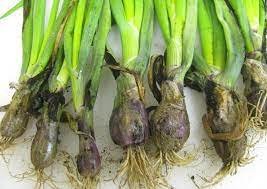
Smut of Onion
Causal organism: Urocystis magica (syn.= U. cepulae) and U. colchici.
Origin: Smut was first observed on the onion in the Connecticut River valley of the USA in 1869.
Symptoms of Smut of Onion
- The earliest symptom appears on cotyledons and young leaves as longitudinal blisters that are blackish with a silver sheen.
- Dark pustules (sori) appear as slightly thickened areas at the base of seedlings near ground level. Blisters rupture to expose black, powdery spore masses (smut teliospores).
- The seedling often dies before emergence. A large lesion can cause leaves to curve downward and usually are shed prematurely.
- The infection progresses inward from leaf to leaf, and infected leaves become stunted and may die within 3-4 weeks after emergence.
- If the plants survive, the disease becomes systemic, and they remain at a vegetative stage for the entire growing season.
- Elongated, raised black blisters can also be found in the outer scales of the developing bulb.
Favorable condition of Smut of Onion
- The optimum temperature for spore germination and growth is 13-22C.
- Infection of the seedling can occur equally well at a temperature of 12-25C.
- Above 29C, Onion seedlings grow without infection in even heavily infested soil.
Control Measures/Management of Smut of Onion
- Prevent soil and plant debris movement among fields to prevent the smut pathogen from being introduced into other fields.
- Practice a threeyear or longer rotation to nonhosts such as small grains and corn.
- Transplants should be used instead of seeds in infested soil.
- The disease can be controlled by seed treatment with Thiram @ 45 gm for 0.45 kg of seed.
- Spraying formaldehyde solution in the furrow.
